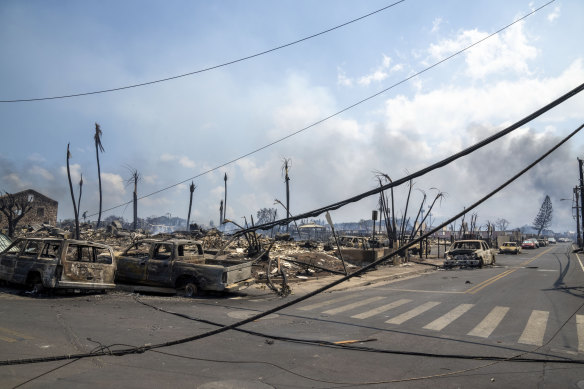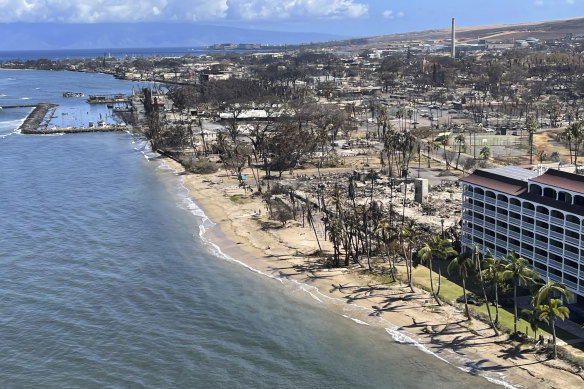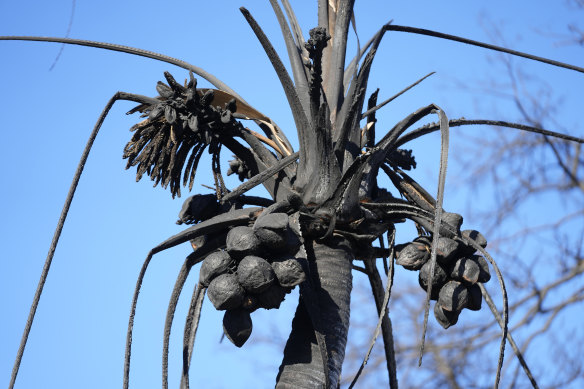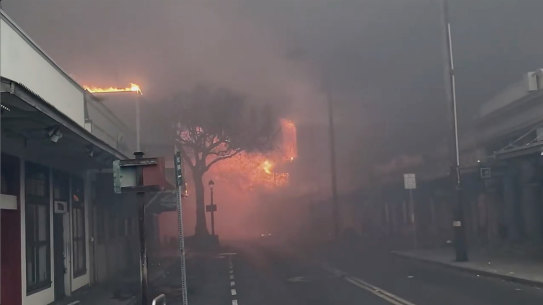ByMark Chediak and Jef Feeley
August 14, 2023 —
San Francisco: While the cause of the deadly Maui fires remains under investigation, lawyers are sending experts to the island to look into utility power lines as being a possible source of ignition.
Attorneys with Watts Guerra, Singleton Schreiber, and Frantz Law Group said they have been collecting evidence, interviewing witnesses and reviewing reports that indicate that damaged power infrastructure owned by Hawaiian Electric Industries created the spark for the flames.

What appear to be power lines down at the scene at one of Maui’s tourist hubs which was reduced to wreckage by the fires.CREDIT:AP
“All evidence – videos, witness accounts, burn progression, and utility equipment remaining – points to Hawaiian Electric’s equipment being the ignition source of the fire that devastated Lahaina,” said Mikal Watts, a Puerto Rico-based plaintiffs lawyer at Watts Guerra who has won millions of dollars in settlements in other wildfire cases, including against California utility giant PG&E Corp.
Hawaiian Electric said it doesn’t have information on what caused the fires, according to an email statement from spokesman Darren Pai. “Access to the impacted area is also limited for safety and emergency response concerns,” Pai said. “After the immediate emergency has passed, we will work with the County and others to investigate what happened on Maui.”
Officials haven’t said what sparked the blazes that were fanned by hurricane-force winds and levelled the historic town of Lahaina. The investigation into what Hawaii Governor Josh Green described as the state’s largest-ever natural disaster could take weeks or months to produce an official determination of the cause.

Burnt areas in Lahaina on the Maui island, Hawaii.CREDIT:AP
Emergency workers on Saturday continued to dig through the ash and rubble, with the official death count from the fires rising to 93.
Hawaiian Electric, which operates the Maui Electric utility, has come under criticism for not turning off power despite warnings of critical fire conditions due to predicted dry, gale-force winds.
The utility earlier this week said strong winds downed electric power lines and snapped power poles ahead of the blazes.
That said, many things can spark a fire in the right conditions, including backfiring cars and trucks dragging chains along a road.

A burnt coconut tree in Lahaina, Hawaii.CREDIT:AP
Sensors that monitor power flow into households detected a major grid fault just after 11.38pm local time on August 7, about 20 minutes before a fire was first reported in Maui, followed by dozens of faults overnight, said Bob Marshall, chief executive officer of Whisker Labs.
The company’s plug-in household devices determine whether a fault is taking place on utility equipment through the magnitude of voltage swings. In Maui, the strongest readings came around Lahaina.
While Marshall cautioned that it’s not clear whether the faults were the ignition sources, he said that fires need a spark and there is “clear data showing dozens of major grid faults in the area of the fires and around the start times of the fires”.
There was no reported lightning at the time and it’s unlikely people were camping with high winds and a red flag warning, he added.
RELATED ARTICLE

Maui fires
Warning sirens did not sound on Maui, Hawaii official confirms
Michael Wara, a wildfire expert who is director of the Climate and Energy Policy Program at Stanford University, said there is “no question” that the utility should have cut power to reduce wildfire risk with the forecast of gusty winds.
The controversial practice is now used by utilities in California, Nevada and Oregon after power lines sparked catastrophic fires during dry windstorms in California.
“We had a situation here with very high winds, very high heat,” said James Frantz, whose firm, Frantz Law Group, is looking at power lines as a culprit and has been signing up residents and businesses in Maui who lost their homes.
“And all those factors call for de-energising those lines when that event occurs. They did not do that and they had the power to do it.”
Frantz Law Group has an office in Honolulu and is working with a local law firm on the investigation.
Hawaii Electric doesn’t have a formal power shutoff program for fire risk, Pai said.

The death toll from the wildfires in Hawaii has risen to 80, making it one of the deadliest blazes in recent US history.
“Preemptive, short-notice power shutoffs have to be coordinated with first responders and in Lahaina, electricity powers the pumps that provide the water needed for firefighting,” Pai said. The utility has a “robust wildfire mitigation and grid resiliency program that includes vegetation management, grid hardening investments and regular inspection of our assets,” he added.
The blaze that razed Lahaina damaged or destroyed 2207 structures, the majority of them residential, with an estimated capital cost of approximately $US5.5 billion ($8.5 billion), according to a damage assessment released Saturday by the Pacific Disaster Centre and the Federal Emergency Management Agency.
Plaintiff lawyers often dispatch representatives of their offices to sign up clients in the wake of wildfire disasters. The plaintiff law firms now working in Maui represented fire victims in a $US13.5 billion settlement with PG&E, which was driven into bankruptcy in 2019 after its utility equipment sparked some of the deadliest wildfires in California history.
Attorney Gerald Singleton said his group, Singleton Schreiber, was flying investigators to Maui this weekend to look into witness accounts of falling power lines and then fires starting, although an actual cause has yet to be determined.
“This wasn’t something they couldn’t have predicted,” Singleton said of the high winds taking down lines. “It’s hard to understand why more precautions weren’t taken.”
If there is a link to power lines, Hawaiian Electric will have to be shown to be negligent or that it could have reasonably prevented a loss, a higher legal standard than the one applied to utilities in California, according to a note Friday by Guggenheim Securities.
Bloomberg
No comments:
Post a Comment